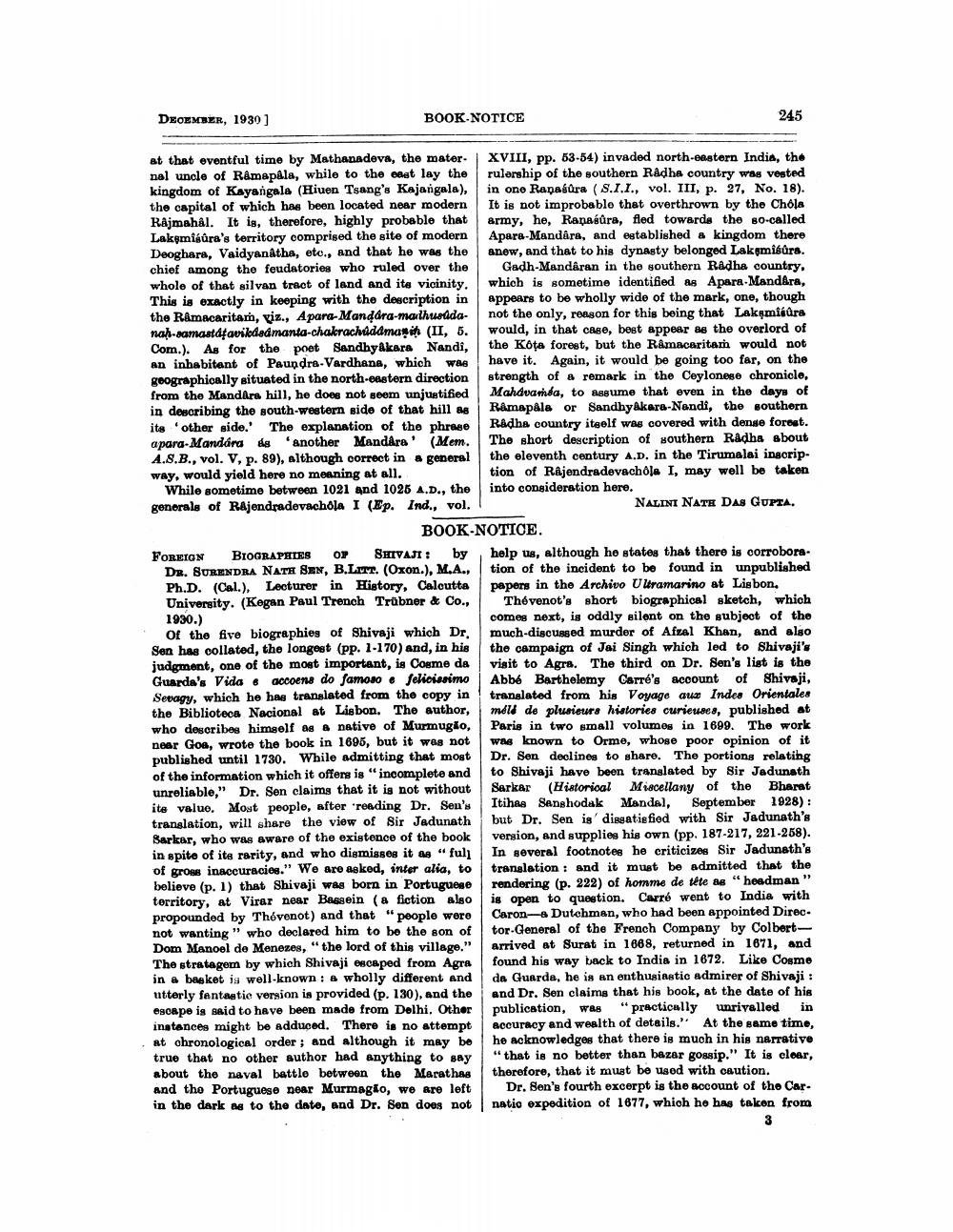________________
DECEMBER, 1930 ]
BOOK NOTICE
245
at that eventful time by Mathanadeva, the mater. XVIII, pp. 53-54) invaded north-eastern India, the nal uncle of Ramapala, whilo to the east lay the rulership of the southern Radha country was vested kingdom of Kayangala (Hiuen Tsang's Kajangala), in ono Rapasūra (S.I.I., vol. III, p. 27, No. 18). the capital of which has been located near modern It is not improbable that overthrown by the Chola RAjmahal. It is, therefore, highly probable that army, he, Ranasura, fled towards the so-called Laksmisura's territory comprised the site of modern Apare-Mandara, and established a kingdom there Deoghara, Vaidyanatha, etc., and that he was the anew, and that to his dynasty belonged Lakemisúrs. chief among the feudatories who ruled over the Gadh-Mandaran in the southern Radha country, whole of that silvan tract of land and its vicinity. which is sometime identified as Apara. MandAra, This is exactly in keeping with the description in appears to be wholly wide of the mark, one, though the Råmacaritam, viz., Apara-Mandara-malhudda- not the only, reason for this being that Lakşmibara nah-samastafavildedmanta-chakrachudamar ih (II, 5. would, in that case, best appear be the overlord of Com.). As for the poet SandhyAkara Nandi, the Kota forest, but the R&macaritam would not an inhabitant of Paundra-Vardhane, which wie have it. Again, it would be going too far, on the geographically situated in the north-eastern direction strength of a remark in the Ceylonese chroniolo, from the Mandara hill, he does not seem unjustified Mahduamda, to assume that even in the days of in describing the south-western side of that hill as Ramapala or Sandhyakars-Nandi, the southern its other side. The explanation of the phrase Radha country iteelf was covered with denge foregt. a para-Mandára 18 another MandAra' (Mem. The short description of southern Radha about A.S.B., vol. V, p. 89), although correct in a general the eleventh century A.D. in the Tirumalai inscripway, would yield here no meaning at all.
tion of Rajendradevachola I, may well be taken While sometime between 1021 and 1025 A.D., the into consideration here. generals of Rajendradevachola I (Ep. Ind., vol.
NALINI NATE DAS GUPTA.
BOOK-NOTICE. FOREIGN BIOGRAPHIES OY SHIVAJI : by, help us, although he states that there is corrobora
Dr. SURENDRA NATH SEN, B.Lurr. (Oxon.), M.A., tion of the incident to be found in unpublished Ph.D. (Cal.), Lecturer in History, Calcutta papers in the Archivo Ultramarino at Lisbon. University. (Kegan Paul Trench Trübner & Co., Thévenot's short biographical sketch, which 1930.)
comes next, is oddly silent on the subject of the of the five biographies of Shivaji which Dr. much-discussed murder of Afzal Khan, and also Sen has collated, the longest (pp. 1-170) and, in his the campaign of Jai Singh which led to Shivaji's judgment, one of the most important, is Cosme da visit to Agra. The third on Dr. Sen's list is the Guarda's Vida & accoens do famoso felicissimo Abbé Barthelemy Carre's account of Shivaji, Sevagy, which he has translated from the copy in translated from his Voyage au Indes Orientales the Biblioteca Nacional at Lisbon. The author, meld de plusieurs histories curieuses, published at who donoribes himself as a native of Murmugko, Paris in two small volumes in 1699. The work near Goa, wrote the book in 1695, but it was not was known to Orme, whose poor opinion of it published until 1730. While admitting that most Dr. Son declines to share. The portions relating of the information which it offers is "incomplete and to Shivaji have been translated by Sir Jadunath unreliable," Dr. Sen claims that it is not without Sarkar (Historical Miscellany of the Bharat ite valuo. Most people, after reading Dr. Seu's Itihas Sanghodak Mandal, September 1928) : translation, will share the view of Sir Jadunath but Dr. Sen is diegatiefied with Sir Jadunath's Barkar, who was aware of the existence of the book version, and supplies his own (pp. 187-217, 221-258). in spite of its rarity, and who digmisses it as "fuli In several footnotee he criticizes Sir Jadunath's of gross inaccuracies." We are asked, inter alia, to translation and it must be admitted that the believe (p. 1) that Shivaji was born in Portuguese rendering (p. 222) of homme de tête de "headman" territory, at Viror near Bassein (a fiction algo is open to question. Carré went to India with propounded by Thévenot) and that "people were Caron-- Dutchman, who had been appointed Direc. not wanting" who declared him to be the son of tor-General of the French Company by ColbertDom Manoel de Menezes, "the lord of this village." arrived at Surat in 1668, returned in 1671, and The stratagem by which Shivaji escaped from Agra found his way back to India in 1672. Like Cosme in a basket is well-known: a wholly different and da Guarda, he is an enthusiastic admirer of Shivaji : utterly fantastie version is provided (p. 130), and the and Dr. Sen claims that his book, at the date of his escape is said to have been made from Delhi, Other publication, was "practically unrivalled in instances might be adduced. There is no attempt accuracy and wealth of details. At the same time, at chronological order; and although it may be he acknowledges that there is much in his narrative true that no other author had anything to say "that is no better than bazar gossip." It is clear, about the naval battle between the Marathas therefore, that it must be used with caution. and the Portuguese near Murmagio, we are left Dr. Ben's fourth excerpt is the socount of the Car. in the dark me to the dato, and Dr. Son does not natio expedition of 1077, which he has taken from




